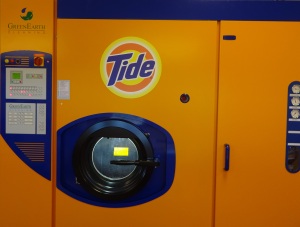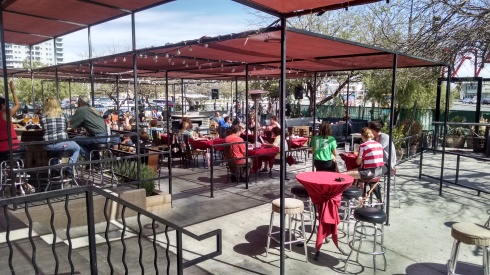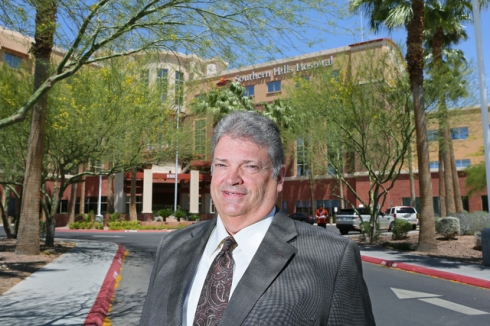Proctor &Gamble, an iconic brand in household cleaning product, is out to change the dry cleaning industry with its Tide branded dry cleaners.
It’s the most locally visible of several new approaches to changing the way dry cleaning is done.
Obviously the Tide shops can’t use standard Tide detergent for dry cleaning. But they can leverage the Tide brand to stake out a new niche in this competitive market — a more environmentally safe dry cleaning process.
And, if you use the Tide Cleaners’ laundry service, your clothes will be washed with Tide and Downy.
The process
Despite its label, dry cleaning is not totally dry. It involves the use of liquid chemicals called solvents that remove most stains from a variety of fabrics. The process of dry cleaning came about quite by accident. In 1855, Jean-Baptiste Jolly noticed that his tablecloth was cleaner after his maid accidentally spilled kerosene on the table. As the dry cleaning process began to spread, early proprietors used kerosene or even gasoline to wash clothes. However, the use was dangerous and led to many fires and explosions.
After World War I, cleaners started to experiment with various chlorinated solvents that were much less flammable and, as it turned out, had much greater cleaning power. By the mid-1930s, the dry cleaning industry had adopted a chemical known as perchloroethylene (commonly known as perc) as its standard.
Dry cleaners usually treat spots by hand before placing garments in large machines filled with a liquid solution that is mostly perc and very little water, if any. The garments are either dried in the same machine or placed into a separate dryer, then pressed and sent out the door in those nifty plastic bags.
The EPA has determined that perc is a “likely human carcinogen” but does not believe that wearing clothes cleaned with perc pose a risk of concern. However, over a sustained period, exposure to perc can cause adverse non-cancer effects on the human nervous system. Long-term exposure can also pose a potential human health hazard to reproduction and development, and to the kidney, liver, immune and hematologic systems. People exposed to high levels of perc, even for brief periods, may experience symptoms such as dizziness, fatigue, headaches, confusion, nausea, and skin, lung, eye, and mucous membrane irritation. If your dry cleaned clothes are left in the plastic bags to hang in the closet, the perc chemical is never given a chance to evaporate which may intensify the effects the first time that the garment is worn.
Cleaning up a mess
Across the country, perc is regulated as a hazardous material. During the recent Nevada legislative session, SB89 was passed adding perc to the list of chemicals that can receive money from the Nevada Petroleum Fund to remediate hazardous spills. In total, there are 24 dry cleaner spills in Clark County that will be cleaned up with fund allocations.
One such action involves cleaning up groundwater contaminated by chemicals from a dry cleaning business that used to operate at the Maryland Square Shopping Center. The spill has migrated across Maryland Parkway, under the Boulevard Mall and is encroaching on the houses behind the mall. Tens of thousands of dollars have been spent on this spill over the past 20 years. With money from the Petroleum Fund, plans are now being made to speed up the process and initiate measures to stop the spill before it reaches the homes.
In 2007, California passed a law that shut down older dry clean machines by 2010 and requires all perc machines to be taken out of service by 2023. Other states across the country are looking to introduce similar legislation.
Seeing the growing backlash against perc, ExxonMobil introduced a more environmentally friendly dry cleaning product called DF-2000. The product is a synthetic hydrocarbon fluid, the use of which has grown throughout the U.S. In Las Vegas, there are a number of dry cleaning operations including Boston Cleaners, AllStar Dry Cleaners, Green Cleaners and Alteration Center, and Green World Cleaners using this product in Las Vegas. Although this product is still a hydrocarbon product with a slight odor and high flash point, it is much less toxic than perc and promoted as a “greener” alternative.
Unlike California, Nevada officials are not putting pressure on dry cleaners to stop using perc. However, new dry cleaning competitors are hoping that consumers vote with their wallets by embracing the more environmentally friendly shops.
Tide Cleaners, along with several other “eco” branded dry cleaning operations in Las Vegas, are using a patented system developed by Green-Earth Cleaning in Kansas City. The system uses liquid silicone known as D5 in place of petrochemicals. D5 is essentially liquefied sand silicone that is non-hazardous and non-toxic when released to the environment, and safely breaks down into the three natural elements — sand, trace amounts of water, and carbon dioxide — all of which are safe for the air, water and soil. Liquid silicone is so safe that you can rub it on your skin and eat it without adverse side effects. In fact, you probably already do as it is the base ingredient in many chapsticks that you ingest after applying to your lips. It also is in many everyday shampoos, conditioners, deodorants, creams, and lotions.
According to manufacturer statements, “Because clothes cleaned the GreenEarth way aren’t bathed in perc or other petrochemical solvents, they come back fresh and clean without unpleasant ‘dry cleaning’ odor. Green-Earth is also very gentle on clothes. You can actually see and feel the difference it makes. Colors don’t fade and whites don’t gray or yellow the way they do in traditional dry cleaning, even after repeated cleaning. Everything feels better too. Fabrics are smooth and silky, and sweaters feel soft and supple again.”
Tide has opened a total of 32 franchise operations across the US. The GreenEarth system is currently being used in 900 U.S. locations and, around the world in 1,700 locations and over 40 countries.
Another approach
While both the traditional dry cleaning and new GreenEarth technologies use little water, another environmentally safe option that is gaining traction is based on the cleaning power of water.
While the professional wet cleaning process doesn’t seem to have made its Las Vegas debut yet, the approach uses computer-controlled washers and dryers, specially formulated detergents, and specialized finishing equipment to create a cost-effective alternative to dry cleaning.
In this process, a computer controls the rotation of the cleaning drum to minimize agitation while providing sufficient movement for effective garment cleaning. Wet clean washers are also equipped with a computer programmed detergent injection system, which allows the cleaner to specify the amount and type of wet clean detergent used for each load. Biodegradable wet clean detergents have been formulated by detergent manufacturers to maximize cleaning power while minimizing color change and shrinkage.
Wet clean dryers include computer controls to assure that garments retain a proper amount of moisture after the dry cycle is complete. Specialized tensioning pressing machines are used to enhance the restoration of constructed garments, such as suit jackets, suit pants, and tailored items. There are a number of companies that manufacture professional wet cleaning washer and dryer systems, tensioning equipment presses, and professional wet cleaning detergents and additives.
While professional wet cleaning systems claim to be the most environmentally friendly because of their use of water, it is also a major environmental drawback. Water, as we know, is becoming a more precious and decreasingly available commodity.
– See more at: http://businesspress.vegas/small-business/new-dry-cleaning-technology-gains-eco-friendly-promise#sthash.fB5mWptQ.dpuf



